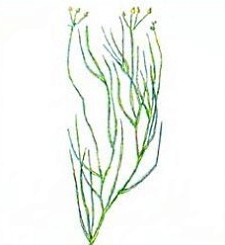Wildlife - Species

Widgeon Grass (Ruppia maritima)
Description
Widgeon grass belongs to the ditch-grass family (Ruppiaceae) and is a submersed aquatic grass. The stems are simple or branched, and the leaves are alternate and threadlike. The leaves reach a maximum length of 10 cm (4 in) and width of 0.6 mm. The flowers are small and white, and the fruits are roundish, dark and 2-3 mm long.
Preferred Habitat and Biology
Natural and cultivated populations of widgeon grass are found along the Atlantic and Pacific coasts and in wetlands throughout the Midwestern and Western states. They grow in alkaline, brackish or saline waters between 2 and 19 ppt. However, the plants have been observed growing in hypersaline waters (77 ppt) and in freshwater. Also, the species grows best in calm waters and permanently flooded wetlands.
Widgeon grass appears to have two growing seasons (spring and fall) that are controlled by water temperature ranging from 18.5°C to 30°C. When the temperature falls outside this range, vegetative growth ceases. Water depth and turbidity are the major factors influencing the vegetative growth of widgeon grass. The best vegetative growth of widgeon grass occurs when water depth is maintained between 40 and 61 cm (15-24 in) and the concentration of suspended material (a measure of turbidity) stays below 55 ppm. Turbidity was found to be most harmful to young plants before the stems reached the surface of the water. Reproductive activities are most affected by water temperature and soil salinity. Widgeon grass seeds do not germinate until the water temperature rises above 15°C, and the temperature must be above 20°C for seedling growth. Flowering and fruiting usually starts in May when the water temperature is above 29°C. Although widgeon grass is a halophyte (salt-tolerant plant) and adults can survive in soils with salinity as high as 3%, levels above 1.12% are extremely harmful to germination and in many cases will cause seed mortality.
Species Significance
Widgeon grass is one of the most valuable aquatic plants for migrating waterfowl. All parts of the plant are edible and are consumed by the ducks that frequent the impoundments of the ACE Basin, including black ducks, mallards, and scaups. Widgeon grass is common throughout its range, and many landowners in the ACE Basin manage their impoundments for this species.
References
Godfrey, R.K. and J.W. Wooten. 1981. Aquatic and wetland plants of southeastern United States: Dicotyledons. The University of Georgia Press, Athens, GA.
Joanen, T. and L.L. Glasgow. 1965. Factors influencing the establishment of widgeongrass stands in Louisiana. Proceedings of the Nineteenth Annual Conference Southeastern Association of Game and Fish Commissioners. Published by the Southeastern Association of Game and Fish Commissioners. Columbia, SC.
Martin, A.C., H.S. Zim, and A.L. Nelson. 1951. American wildlife and plants: A guide to wildlife food habits. Dover Publications Inc., New York, NY.
